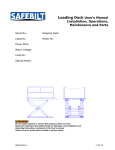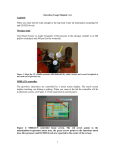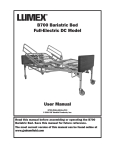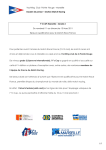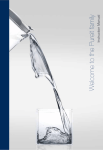Download Standard Operating Procedures MBraun Glove Chamber
Transcript
Standard Operating Procedures MBraun Glove Chamber Primary Administrator: James Radich – Room 211 Secondary Administrator: Doug Hines – Room 211 The MBraun glove chamber is used for the construction of devices requiring fully inert conditions (no oxygen or water). The glove chamber contains a recirculating gas system with a catalyst to remove impurities from the inner atmosphere. Care must be exercised in maintaining the inert atmosphere and to avoid potentially hazardous conditions, as the glove chamber may include materials inside that react violently with air and/or water. A. BEFORE BEGINNING – MOST IMPORTANT POINTS 1. READ THE OPERATOR’S MANUAL AND UNDERGO TRAINING BY ONE OF THE ADMINISTRATORS BEFORE USING THE GLOVE CHAMBER 2. Always check the pressure on the argon cylinder that feeds the glove chamber. If the pressure is below 500 psi, STOP IMMEDIATELY and refer to instructions on how to change the argon gas cylinder, section B of this SOP. 3. Check the sensor readings on the digital readout to ensure the O2 and H2O levels are below 0.1 ppm. 4. Check the digital readout for any alarm messages. If the Alarm Button is flashing, push the button and notify the glove chamber administrator as to what the alarm message indicates as the issue. 5. Ensure the Circulation Purifier is on. The button on the digital readout will be red, and the circulation pump will be audible. B. Exchanging Gas Cylinder for MBraun Glove Chamber 1. Stop the Circulation Purifier by pushing the button on the digital readout. 2. Close the main valve on the used gas cylinder. This is the valve directly on top of the cylinder. 3. Step on the “Low Pressure” pedal until the low-pressure reading on the regulator drops to less than 10 psi. Initially, the high-pressure side will feed the low-pressure side until the high-pressure readout drops to zero. DO NOT GO ALL THE WAY TO ZERO ON THE LOW-PRESSURE READOUT! 4. Unscrew the hose clamp securing the tubing to the regulator. Carefully remove the tubing from the barbed tip from the regulator. IMMEDIATELY insert the designated tube stopper into the tubing to prevent air from entering the tubing. 5. Double check that both the low and high pressure gauges read zero at this point. 6. Double check that the cylinder valve is tightly closed. 7. Close the low-pressure valve at the outlet of the regulator. 8. Unscrew the regulator from the gas cylinder using a pipe wrench or crescent wrench. Remove the regulator from the gas cylinder. 9. Screw the cap back onto the top of the gas cylinder. 10. Unstrap the gas cylinder from the wall and carefully set aside. 11. Unstrap the new gas cylinder from the cylinder dolly. Maneuver the gas cylinder carefully into position. Strap the new gas cylinder into position. 12. Strap the old gas cylinder onto the cylinder dolly. 13. Use Teflon tape to make one-layer coating on the regulator tip. Screw the regulator back into the gas cylinder using the crescent wrench to tighten. Make sure regulator is secured tightly into the cylinder. 14. Remove the Tube Stopper and immediately feed the tubing back onto the regulator outlet barb. Pull the hose clamp over the barb and tighten securely with the screwdriver. 15. Double check that all fittings are tight and secure. 16. Open the new gas cylinder using the valve on top of the cylinder. 17. Ensure the high-pressure side reads ~2600 psi and the low pressure side ~60 psi. 18. Open the valve at the outlet of the regulator. 19. Turn on the Circulation Purifier 20. Use the pedals to change from low- to high-pressure conditions to ensure the chamber gas system is functioning properly. 21. Sometimes the O2 level may increase slightly as a result of air entrained in the tubing. This will correct itself within a few minutes. C. Vacuum/Purge Cycles for Inert Conditions in the Exchange Chamber 1. The chambers should be fully evacuated and held at vacuum level for at least 1 minute (small) or 5 minutes (large) between each evacuation/refill cycle. 2. For the small chamber, rotate the lever below the chamber clockwise to vacuum the chamber. After holding the vacuum for 1 minute, slowly rotate the lever counterclockwise until inert gas begins to flow. Depending on what is in the exchange chamber, limited gas flow may be required to prevent disturbance of samples. Otherwise, rotate the lever fully counterclockwise until the pressure gauge returns to atmospheric conditions. 3. For the large chamber use the buttons on the digital readout per the User’s Manual D. Inserting or Removing Materials from the Glove Chamber 1. For large objects use the large exchange chamber; for small objects, use the small exchange chamber. 2. Insert the items into the exchange chamber. NOTE: before removing items from the glove chamber, ensure the exchange chamber has been purged of atmospheric gases and contains only argon. Items being removed from the glove chamber can be inserted into the inert exchange chamber, the door closed, and immediately removed from the other side. NEVER OPEN THE EXCHANGE CHAMBER DOOR INSIDE THE GLOVE BOX WITHOUT ENSURING THE EXCHANGE CHAMBER IS FULLY INERT!! 3. After removal of the items from the exchange chamber, perform vacuum/purge cycle 3 times to re-inert the exchange chamber. The exchange chamber should always contain inert gas. 4. General use materials such as a box of KimWipes should be opened before placing into the exchange chamber, and extra time under vacuum should be afforded to allow all adsorbed atmospheric gases to be removed from the deepest wipes within the bottom of the box. 5. LIQUIDS: To insert or remove liquid materials from the glove chamber, proper seals must be used. When placing the exchange chamber under vacuum, liquids will boil and cause serious issues with the vacuum system. A screw-cap or septum with hose clamp MUST be used to bring liquids through the exchange chamber. E. General Safe Practices for Glove Chamber Operation 1. If using needles always keep the needle tip pointed away from the gloves. 2. Ensure any solvents or chemicals used are compatible with the glove material. 3. Keep a proper waste container inside the glove chamber for the specific chemicals used. 4. Screw any solvent caps back onto the container after using them to avoid evaporation. This will strain the catalyst system that purifies the atmosphere inside the glove chamber. 5. Keep oxygen- or water-reactive materials inside another container within the glove chamber to avoid reaction in the event of an incident that allows oxygen or water into the glove chamber. An incident of this type may occur when no one is inside the laboratory 6. You must understand how to quench any undesirable reaction with the materials in the glove chamber. The quenching material must be placed in the glove box and identified prior to beginning work with the highly-reactive material. F. Emergency Procedures for MBraun Glove Chamber with Atmosphere Breach 1. If highly-reactive materials are open in the glove chamber and a breach of the inert atmosphere is observed, first put the reactive materials into the secondary storage container. If the breach occurred previously and the secondary container contains impurities, ensure the reactive materials are over the steel plate to prevent further breach or corrosion of the glove chamber floor. 2. Use the Quick Purge function on the digital readout to continually purge the glove chamber with inert gas. The Circulation Purifier must be turned off for the Quick Purge option to become available. 3. Purge the glove chamber until the oxygen levels drop below 10 ppm. Turn on the Circulation Purifier. At this point it is more advantageous to allow the catalyst system to remove the remaining impurities. 4. Monitor the concentrations of O2 and H2O until both return to less than 0.1 ppm.








![588-589-00a [Converted]](http://vs1.manualzilla.com/store/data/005638396_1-02d08bb06dde3fa2099be559e669b8e9-150x150.png)

